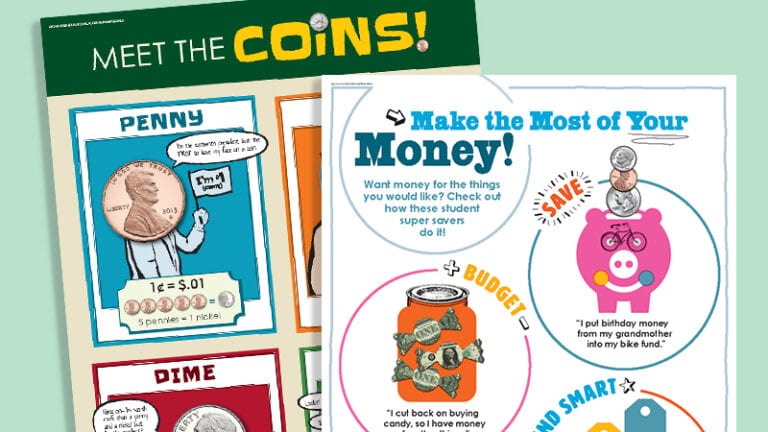Financial literacy is a great way to bridge home and school when it comes to math. These resources from Hands on Banking can be used as stand-alone resources to send home to families, perhaps in a newsletter or at a back-to-school night. Or you can extend classroom lessons to home.
1. Interview a family member about their first job
Talk About Your First Job (ages 7-12)
Get students and their families talking with these interview questions about working. Students are prompted to ask parents or other family members about their first job, how they were paid and what they did with the money they earned. (Also available in Spanish.)
2. Do some comparison shopping (and plan a family event)
Plan a Family Fun Event (ages 8-12)
In this take-home activity, families are asked to do some basic math together, looking at the prices of the same items at two different stores. Next, they can put those bargain-hunting skills to use by planning their own family event with snacks and entertainment. True fact: Pizza bites taste better when they are on sale.
3. Stick to a budget
Do Some Smart Spending (ages 8-12)
Here’s a fun challenge: Parents can teach their children how to stick to a budget and distinguish between wants and needs while grocery shopping—by limiting spending to a set amount. Maybe don’t try this at Target!
4. Use your family’s interests and talents to give back
Acts of Kindness (ages 6-14)
You Can Help Too (ages 6-14)
Charitable giving doesn’t have to be limited to just donating money. In this activity, families talk through their interests and talents to find an organization in need of their gifts.
5. Research where to donate time or money as a family
Give Until It Helps (ages 12-18)
With gifts and interests identified, this activity guides families to research where they might want to donate. After choosing where to give, it’s time to make a donation plan together.
6. Save for a financial goal
Saving for What I Want (ages 8 to 12)
Planning for a Big Expense (ages 9 – 12)
Budgeting IRL (ages 12 -18)
Saving up for a specific item is a common topic of conversation, but how do families teach children to plan and save for a financial goal? Hands on Banking has activities for families of elementary and middle school students, along with a high school activity focused on budgeting IRL. (Saving for What I Want is also available in Spanish.)
7. Break down a paycheck
Breaking Down a Paycheck (ages 11-18)
As students grow more aware of the usefulness of money, they might also hear that adults have to pay taxes. With this activity, families can talk through a pretend paycheck with their students, exploring deductions like taxes, Social Security, and savings.
Tip: This activity is best for older students in either middle or high school as it asks them to find percentages.
8. Talk about health insurance
Teaching Kids About Health Insurance (ages 13-18)
Talking About Insurance (ages 13-18)
Another aspect of adulthood that students might have questions about is health insurance. Luckily, Hands on Banking has two activities around this topic. The first has families to compare the costs associated with two different health plans. The second is focused on why a young adult should still purchase health insurance even if they’re in good health.
9. Add money (and a little math) into daily conversations
Talking About Money (ages 6-18)
In addition to sending home individual activities, you can also give families the link (or make a printout) of “Talking About Money.” This webpage provides many actionable ideas for starting conversations with students, especially tweens and teens, about personal finance. There is even a list of specific financial activities and decisions that families often make that can be used as teaching moments at home.


